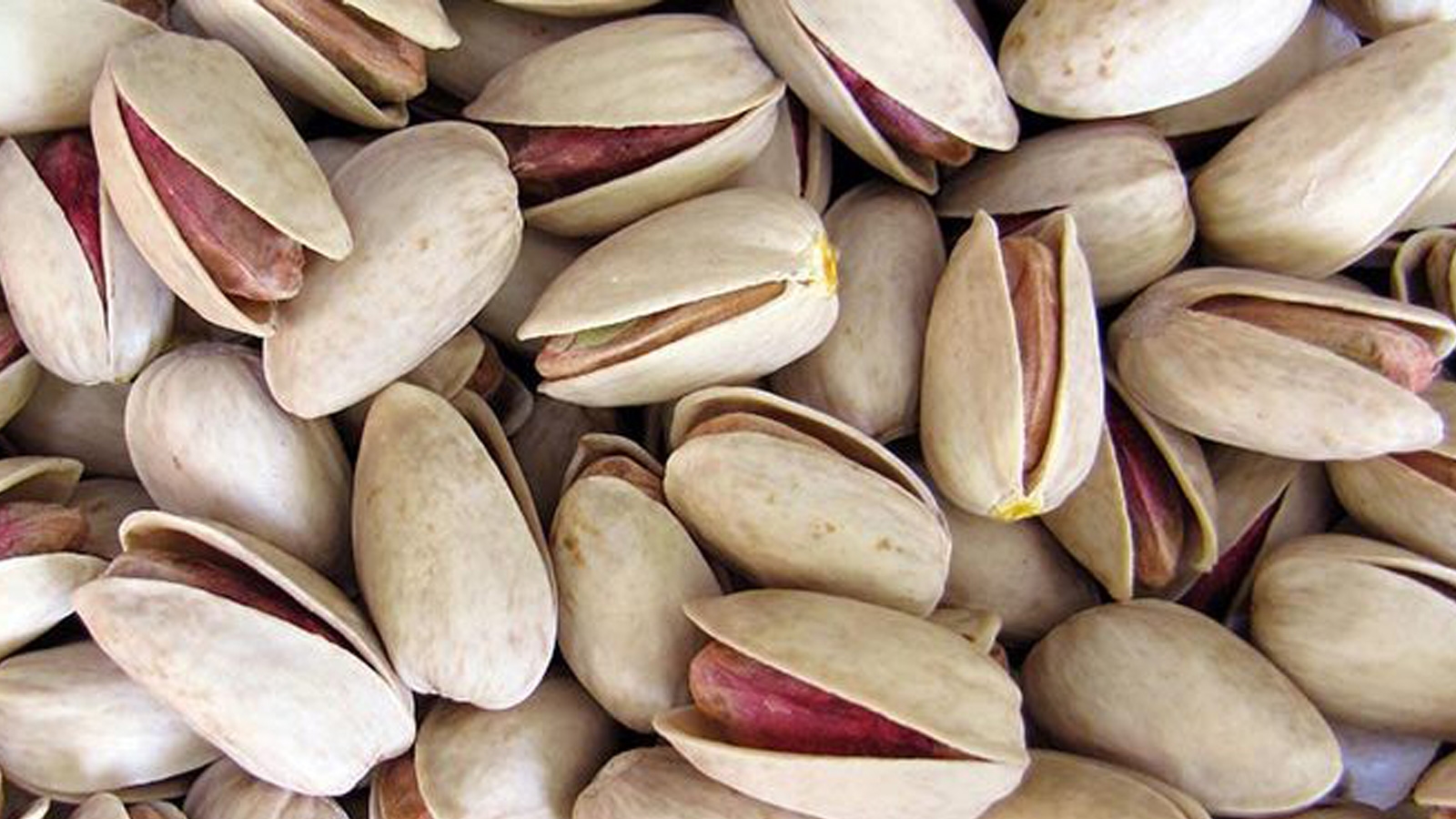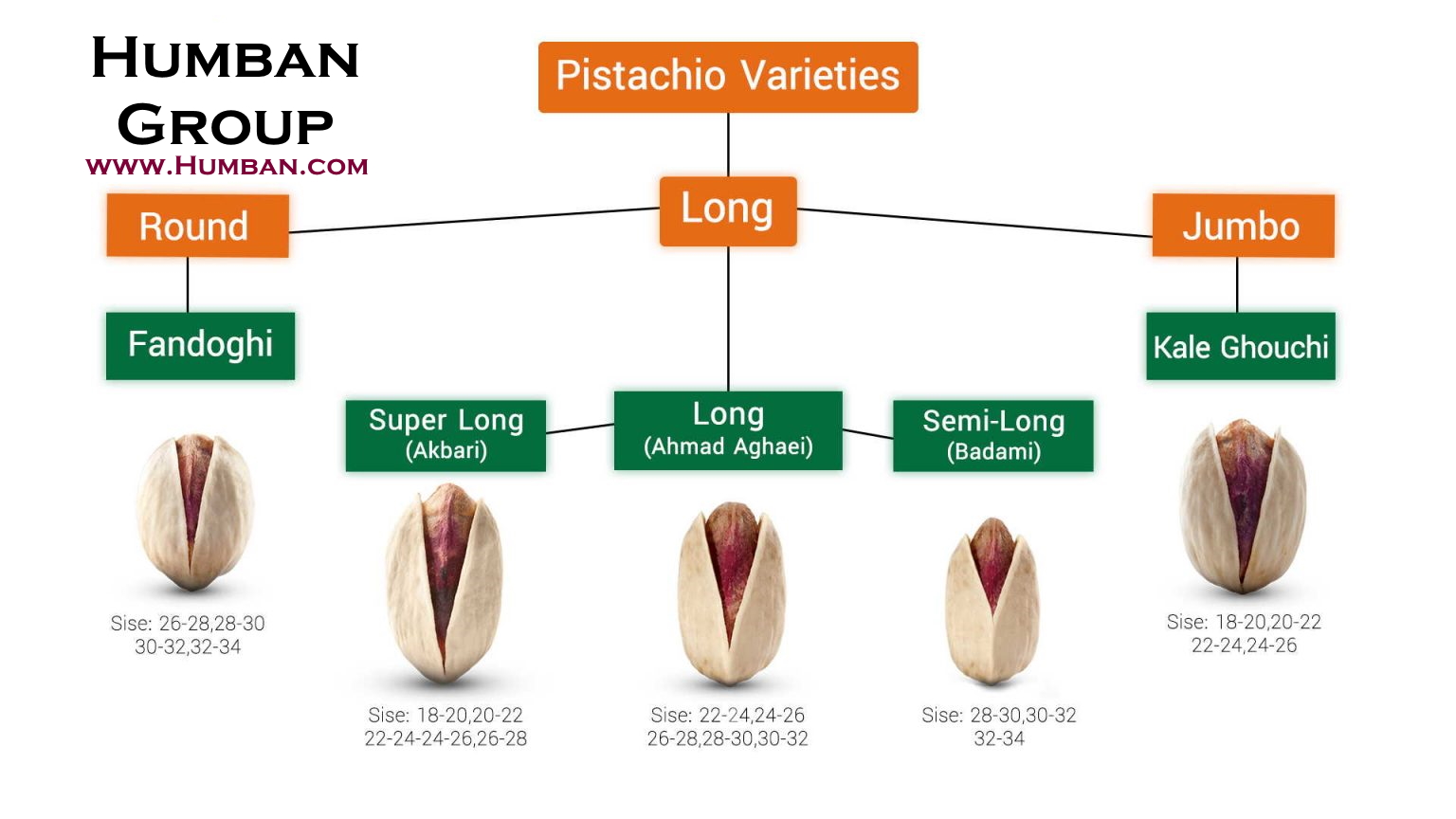
Packaging : 10kg | 25kg | 50kg
This shape of Pistachios is called as BADAMI that is one of the LONG types. The most common characteristic to identify this type is its shape which is reedy and shorter than ahmad aghaei.
It’s also available in 28-30 30-32 sizes.
Badami Pistachio (semi-long), This shape of Pistachios is called as BADAMI that is one of the LONG types. The most common characteristic to identify this type is its shape which is reedy and shorter than ahmad aghaei.

Specifications of Badami Pistachio (Semi – Long Pistachio)
Pistachios, which many of us have known and loved, are the delicious tree nut, Pistachios were popu-lar for thousands of years in middle east where they grow and Nowadays, they have spread through-out the world and are used in all sorts of different cuisines and dishes, from entrees to desserts like ice cream.
Pistachio is known as the “smiling nut” in Iran and the “happy nut” in China.
Pistachios are a great source of healthy fats, fiber, protein, antioxidants and various nutrients, includ-ing vitamin B6 and potassium.
Badami is another type of long Iranian pistachios, and its length size is shorter than Ahmad Aghaei.
The detailed specifications of Semi-long Pistachio is shown in the table below:
| Shape | Semi-Long |
| Type | Naturally Opened |
| Flavor | Raw, Roasted, Roasted and Salted |
| Smell | Naturally pistachio’s aroma without foreign odor |
| Total size | 28/30, 30/32, 32-34 |
| Regular size | 30-32 |
| Moisture | |
| For raw pistachio | 5-7% |
| For Roasted & Salted pistachio | 2-3% |
| Shelf Life and Storage Condition | 24 month, Keep in a cool and dry place, away from direct sunlight |
| Harvesting time | September & October |
| Chemical/Artificial Additives | No, completely natural and healthy, GMO Free, Gluten-Free |
| Packing type in bulk | 10kg Vacuumed carton, 25kg, 50kg pp bags |
| Consumer Packing | from 100g to 1000g in a different kind of packing |
| OEM | Possible |
Applications
Pistachios used directly as a snack or mixed with other nuts, also they can be used as a great super healthy ingredient in foods recipes, confectionery, bakery, different desserts, Ice cream and etc.
BADAMI PISTACHIO
Badami pistachio is one of the essential nuts in Iran and the world and has a high nutritional value. Iran is one of the biggest and most important exporters of pistachios globally, and even it tends to be said that the best kind of pistachio on the planet has a place with Iran.
Besides, pistachio is a critical component of salty and sweet nuts produced in two types, crude and simmered. Knowledge of the kinds of pistachios accessible in Iran can give you more data about this valuable dried fruit.
The pistachio tree
The inception of the pistachio tree most likely traces back to Central or East Asia. Currently, various species of this tree are cultivated in Iran. Pistachio trees have two bases, which implies that male and female blossoms develop on discrete trees.
Along these lines, both male and female roses are absent on a similar tree. The pistachio tree leaves are light green and substitute with 2 or 3 pointed handouts with a terminal pamphlet. The blossoms of the pistachio tree are grouped, and the male flowers don’t have petals.
Different names know pistachios in other Iran regions regarding quality, taste, kernel color, coarseness, smallness, darkness, lightness, and skin color.
In addition to these features, pistachio production also affects this dried fruit’s price in terms of quality. For instance, Damghan pistachio has a prime spot because of its great taste and a ton of fat, Qazvin pistachio has an uncommon area because of the green shade of its bit, and Rafsanjan pistachio has a special place due to its taste and red color of the kernel and also its light skin color.
Aside from the cultivars referenced in the past segment, probably the most renowned kinds of pistachios in Iran are Jabbari Pistachio, Rokany, Italian, Ghanouri, Nahedi, Ali Aghaei Badami pistachio, Badami pistachio Kaj, Seif al-Dini, Heratif Crow Fang, Paper Peel, Badami pistachio Ravar, Shatabadi, Ebrahimabadi, Mumtaz Tajabadi, Hazelnut Riz, Khanjari Ravari and so on.
It is worth considering that among the most important cultivars used for export include Koleghoochi, Hazelnut, Akbari, Ahmad Aghaei, and Badami pistachio cultivars.
Iranian pistachios have various varieties, and so far, more than 70 types of pistachios have been identified and cultivated in Iran.
The most famous Iranian pistachios include Akbari pistachio, Koleghoochi pistachio, Ahmad Aghaei pistachio, pistachio Hazelnut, Shahpasand Damghan pistachio, white pistachio, Nogh pistachio, Qazvini pistachio, and dagger pistachio are Damghan. There are different divisions for different types of pistachios in Iran.
Badami pistachio has a long and elongated shape, such as Akbari and Ahmad Aghaei pistachios or white cultivar Nogh pistachio. These pistachios are classified into the group of Badami pistachio. Badami pistachio is famous in the world for its long and beautiful appearance.
Luxury pistachios are also considered to have a round appearance, such as Koleghoochi and Hazelnut pistachios. Badami pistachio is commercial and export cultivars of Iranian pistachios and sold in various ounces as kernels or shells.
In addition to the reasons mentioned, the rooting and rooting of this cultivar should also be mentioned because in the Badami pistachio cultivar, from three to four roots, it has a straight and deep core.
However, in other cultivars, the roots are sprayed, and all the roots grow almost uniformly and at a shallow depth, up to a particular center, and the roots do not tend to be very deep, which causes more problems in the branches and leaves. But the Badami pistachio cultivar has a straight core that sinks deep into the soil.
It should be noted that the tree’s primary roots are different from the shallow roots, the main root is for the stability and survival of the tree, but most of the roots that gardeners see are for nutrition and growth.
For these reasons, all pistachio experts recommend using Badami pistachio seeds for planting pistachios. The characteristics of the trees of this cultivar are their high growth power and habit of extensive growth.
The length of the tree of this figure is 3.5, and the width of the crown of the tree is 3.5. This cultivar is considered one of the average flower cultivars, and its flowering lasts from 16 April to 27 April.
The beginning of brain growth is from July 10, and the full growth of the brain is August 20. Its brain is red. The softshell color tends to be green when it reaches a bright red.
The position of the bony shell is equal in both the dorsal and abdominal parts. The color of the white bony shell is slightly dull.
Benefits of Badami pistachio
Resistant to salinity:
- Resistant to dehydration
- Resistant to soil fungi
- Resistant to pistachio psyllids (dry juice)
- Having the proper root
- Poor annualization
- Medium loading
Additional information
| Shape | Semi-Long |
|---|---|
| Type | Naturally Opened |
| Flavor | Raw, Roasted, and Salted |
| Smell | Natural |
| Total size | 28/31, 30/33, 32-35 |
| Regular size | 30-33 |
| Moisture | – |
| For raw pistachio | 5-8% |
| For Roasted & Salted pistachio | 2-4% |
| Shelf Life and Storage Condition | 24 months, Put it in a cool and dry area, away from sunlight |
| Harvesting time | September & November |
| Chemical/Artificial Additives | No, completely natural and healthy, without gluten or GMO |
| Packing in bulk | 10kg, 25kg, 50kg bags |
| Consumer Packing for the market | from 100g to 1000g |
| OEM | Possible |
Badami Pistachio and Export
European market
For Iranian pistachios, the rules have been strictly enforced. These include the Aflatoxin Test Certificate, which must be meticulous and meticulous.
Asian market
As well as Europeans, the Asians are now calling for this exact test.
African market
Working with this market is not that serious but our pistachios are exported there.
America market
The US is lower than Iranian pistachios. But Canada is seriously buying Iranian pistachios.
